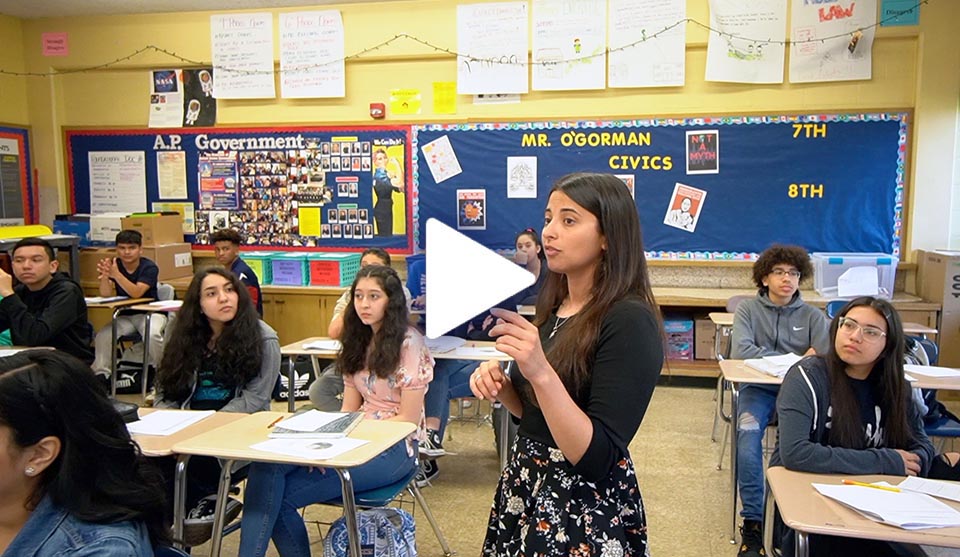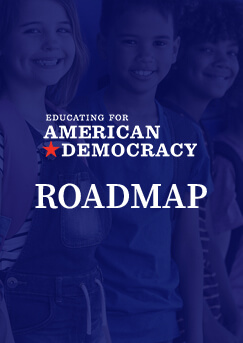In recent decades, we as a nation have failed to prepare young Americans for self-government, leaving the world’s oldest constitutional democracy in grave danger, afflicted by both cynicism and nostalgia, as it approaches its 250th anniversary. The time has come to recommit to the education of our young people for informed, authentic, and engaged citizenship.
Educating for American Democracy (EAD) is an unprecedented effort that convened a diverse and cross-ideological group of scholars and educators to create a Roadmap to Educating for American Democracy— guidance and an inquiry framework that states, local school districts, and educators can use to transform teaching of history and civics to meet the needs of a diverse 21st century K–12 student body.
EAD is a call to action to invest in strengthening history and civic learning, and to ensure that civic learning opportunities are delivered equitably throughout the country.
The Educating for American Democracy (EAD) initiative was funded by the National Endowment for the Humanities and the U.S. Department of Education through a grant to iCivics in collaboration with Harvard University, Tufts University, CIRCLE, and Arizona State University. First proposed in July 2019, the initiative brought together a national network of more than 300 scholars, classroom educators from every grade level, practitioners, and students from a diversity of viewpoints, demographics, and roles, who pooled their expertise to create a strategy for providing excellent history and civics to all students.
Our constitutional democracy is in peril. After years of polarization, the United States is highly divided, and there is widespread loss of confidence in our very form of government and civic order. For many decades, we have neglected civics and history, and we now have a citizenry and electorate who are poorly prepared to understand, appreciate, and use our form of government and civic life.
At the federal level, we spend approximately $50 per student per year on STEM fields and approximately $0.50 per student per year on civics. A lack of consensus about the substance of history and civics—what and how to teach—has been a major obstacle to maintaining excellence. The Educating for American Democracy initiative provides tools to make civics and history a priority so that we as a country can rebuild our civic strength to meet the modern challenges we are facing.
The EAD initiative demonstrates that a viewpoint, demographically, and professionally diverse group can agree about history and civics content, as well as pedagogy. This detailed consensus, presented in a broad roadmap that allows states, localities, and educators to assess and reprioritize their own approaches, will encourage investments in civics and history at all levels.
EAD shifts from breadth to depth by offering an inquiry framework that weaves history and civics together and inspires students to learn by asking difficult questions, then seeking answers in the classroom through facts and discussion. The Roadmap is neither a set of standards nor a curriculum. It recommends approaches to learning that:
- inspire students to want to become involved in their constitutional democracy and help to sustain our republic;
- tell a full and complete narrative of America’s plural yet shared story;
- celebrate the compromises needed to make our constitutional democracy work;
- cultivate civic honesty and patriotism that leaves space to both love and critique this country;
- teach history and civics both through a timeline of events and the themes that run through those events.
The EAD Roadmap includes suggested educational strategies for every grade level, a website of curated examples, and implementation recommendations that each state and district can use to fit the needs of their own, unique communities. It details benchmarks for state-level accountability to support continuous improvement—as well as recommendations for investment in developing a corps of history and civics educators.
Anyone who wishes to promote excellence in history and civics for all learners!
The Roadmap is an advisory document that guides history and civics education curricula via a set of themes, design challenges, and instructional strategies. Given the absence of national standards around history and civics education, the Roadmap is a valuable resource for a variety of important actors in the education process, including:
- Teachers, who can read our library of lesson plans
- The elected officials and policymakers responsible for state standards
- Authors of curricula and textbooks
Although not a collection of lesson plans, the Roadmap helps you rethink and reprioritize what goes into your curricula, allowing you to develop a K—12 educational plan that holistically teaches the full complexity of American history and civics in a way that more deeply engages your local student population.
Find out more about how you, in your specific role, can engage with the Roadmap.
Introducing
The Seven Themes
These seven themes map out the disciplinary and conceptual terrain, as well as the skills and dispositional learning needed to support healthy civic participation.
Civic Participation
This theme explores the relationship between self-government and civic participation, drawing on the discipline of history to explore how citizens’ active engagement has mattered for American society and on the discipline of civics to explore the principles, values, habits, and skills that support productive engagement in a healthy, resilient constitutional democracy.
This theme focuses attention on the overarching goal of engaging young people as civic participants and preparing them to assume that role successfully.
Our Changing Landscapes
This theme begins from the recognition that American civic experience is tied to a particular place, and explores the history of how the United States has come to develop the physical and geographical shape it has, the complex experiences of harm and benefit which that history has delivered to different portions of the American population, and the civics questions of how political communities form in the first place, become connected to specific places, and develop membership rules.
The theme also takes up the question of our contemporary responsibility to the natural world.
We the People
This theme explores the idea of “the people” as a political concept--not just a group of people who share a landscape but a group of people who share political ideals and institutions. The theme explores the history of how the contemporary American people has taken shape as a political body and builds civic understanding about how political institutions and shared ideals can work to connect a diverse population to shared processes of societal decision-making.
The theme also explores the challenge of e pluribus unum: forging one political people out of diverse experiences.
A New Government & Constitution
This theme explores the institutional history of the United States as well as the theoretical underpinnings of constitutional design.
A People in the World
This theme explores the place of the U.S. and the American people in a global context, investigating key historical events in international affairs, and building understanding of the principles, values, and laws at stake in debates about America’s role in the world.
Contemporary Debates & Possibilities
This theme explores the contemporary terrain of civic participation and civic agency, investigating how historical narratives shape current political arguments, how values and information shape policy arguments, and how the American people continue to renew or remake themselves in pursuit of fulfillment of the promise of constitutional democracy.
Introducing
The Five Design Challenges
It’s hard to teach history in a way that’s both honest and aspirational. Our design challenges enable you to transform that tension into a dynamic classroom experience.
Motivating Agency, Sustaining the Republic
- How can we help students understand the full context for their roles as civic participants without creating paralysis or a sense of the insignificance of their own agency in relation to the magnitude of our society, the globe, and shared challenges?
- How can we help students become engaged citizens who also sustain civil disagreement, civic friendship, and thus American constitutional democracy?
- How can we help students pursue civic action that is authentic, responsible, and informed?
This design challenge applies to
- Theme 1: Civic Participation
Civic Honesty, Reflective Patriotism
- How can we offer an account of U.S. constitutional democracy that is simultaneously honest about the wrongs of the past without falling into cynicism, and appreciative of the founding of the United States without tipping into adulation?
This design challenge applies to
Balancing the Concrete & the Abstract
- How can we support instructors in helping students move between concrete, narrative, and chronological learning and thematic and abstract or conceptual learning?
This design challenge applies to
- Theme 6: A People In The World
- Theme 7: A People With Contemporary Debates & Possibilities




